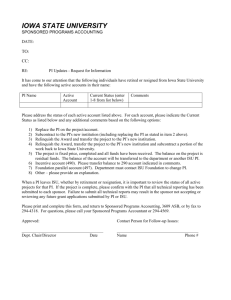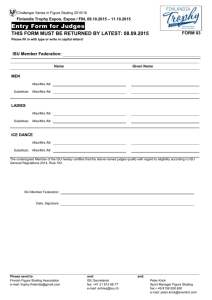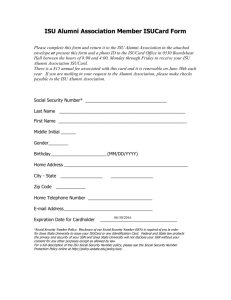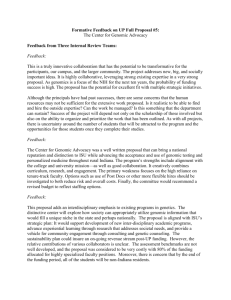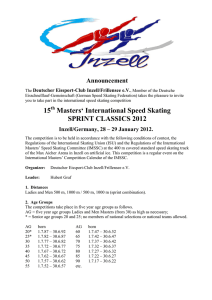INTERNATIONAL SKATING UNION Communication No. 1631
advertisement
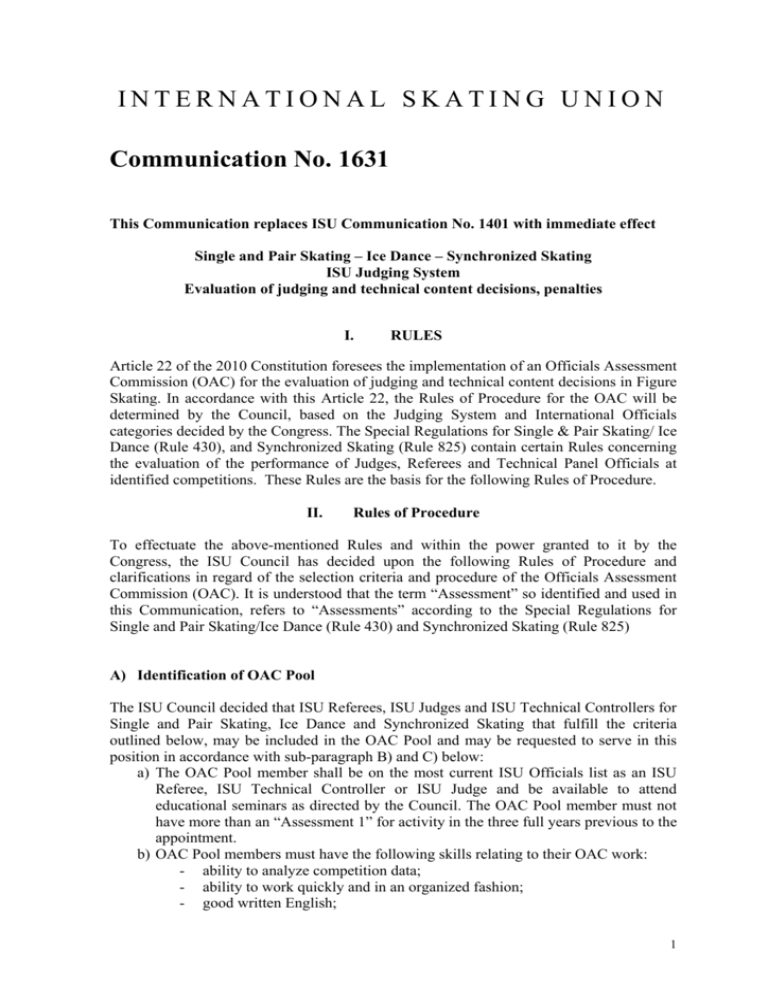
INTERNATIONAL SKATING UNION Communication No. 1631 This Communication replaces ISU Communication No. 1401 with immediate effect Single and Pair Skating – Ice Dance – Synchronized Skating ISU Judging System Evaluation of judging and technical content decisions, penalties I. RULES Article 22 of the 2010 Constitution foresees the implementation of an Officials Assessment Commission (OAC) for the evaluation of judging and technical content decisions in Figure Skating. In accordance with this Article 22, the Rules of Procedure for the OAC will be determined by the Council, based on the Judging System and International Officials categories decided by the Congress. The Special Regulations for Single & Pair Skating/ Ice Dance (Rule 430), and Synchronized Skating (Rule 825) contain certain Rules concerning the evaluation of the performance of Judges, Referees and Technical Panel Officials at identified competitions. These Rules are the basis for the following Rules of Procedure. II. Rules of Procedure To effectuate the above-mentioned Rules and within the power granted to it by the Congress, the ISU Council has decided upon the following Rules of Procedure and clarifications in regard of the selection criteria and procedure of the Officials Assessment Commission (OAC). It is understood that the term “Assessment” so identified and used in this Communication, refers to “Assessments” according to the Special Regulations for Single and Pair Skating/Ice Dance (Rule 430) and Synchronized Skating (Rule 825) A) Identification of OAC Pool The ISU Council decided that ISU Referees, ISU Judges and ISU Technical Controllers for Single and Pair Skating, Ice Dance and Synchronized Skating that fulfill the criteria outlined below, may be included in the OAC Pool and may be requested to serve in this position in accordance with sub-paragraph B) and C) below: a) The OAC Pool member shall be on the most current ISU Officials list as an ISU Referee, ISU Technical Controller or ISU Judge and be available to attend educational seminars as directed by the Council. The OAC Pool member must not have more than an “Assessment 1” for activity in the three full years previous to the appointment. b) OAC Pool members must have the following skills relating to their OAC work: - ability to analyze competition data; - ability to work quickly and in an organized fashion; - good written English; 1 - c) d) e) f) be familiar with report writing; demonstrate an ability to remain objective in all officiating evaluation matters. The ISU Council may periodically revise the above-mentioned criteria based on the experienced gained. The OAC Pool will be identified for service during each “season” from July 1 through the following June 30. If no changes to the OAC Pool members are proposed by the Sports Directorate or the Council by May 31, the same pool members of the out-going season are automatically re-appointed for the following season. The OAC Pool members who actually will be assigned to officiate in the OAC function as per sub-paragraphs B) and C) below, cannot act in any other capacity at the events they have been assigned to act as OAC member. No other restrictions apply to listed OAC Pool members, e.g. they may officiate in other capacities (including judging) at previous or subsequent events but should avoid doing so during the same season as much as possible. When assigning OAC pool members to the events as per paragraph B) below, the ISU will take into account the intentions of the pool members as to their other international officiating assignments during the season. The activity of OAC pool members actually officiating in this capacity at ISU Events (on site or off-site) is counting in every season towards the Officials activity requirements as stated in the Special Regulations. B) Appointment procedure for ISU Championships and OAC members rules of conduct a) In accordance with the Rules referenced in Paragraph I. above, for ISU Championships and Olympic Winter Games this evaluation shall take place, on site of the ISU Events, immediately after the conclusion of each competition by the OAC members assigned by the ISU President. b) To provide consistency among OAC evaluation in all competitions and a “transfer of knowledge”, the assignments will be made in a manner so that if possible at least one assigned OAC member per discipline will be in attendance having previous experience in an OAC assignment. c) The ISU President has the right to assign skating knowledgeable individuals (former international skaters or officials who are still member of a Member) as observers of the work of the OAC on site. In addition, the ISU Secretariat and/or consultants will administratively assist the OAC as required. d) Each Single and Pair Skating/Ice Dance ISU Championships and Olympic Winter Games shall be attended by at least three assigned OAC members, two of whom must be available for Ice Dance and two must be available for Single and Pair Skating. For the Synchronized Skating Championships, 2 OAC Pool members from the Synchronized Skating discipline shall be assigned. e) The assigned OAC members to an ISU Championships (except the World Junior Synchronized Skating Championships) and the Olympic Winter Games shall be in attendance during the full duration of all segments of their respective discipline (Ladies, Men, Pairs or Ice Dance or Synchronized Skating) observing the level of the skaters performance. f) Even though the printouts given to the assigned OAC members do not reveal the Judges names, the assigned OAC members must keep the data made available to 2 g) h) i) j) k) l) m) n) o) them strictly confidential and may not make any comments at any time except when specifically and formally requested by the respective Technical Committee and/or the Council and/or the Sports Directorate and/or the Director General and in any case the data shall not be disclosed to anybody else. OAC Members will also review and check the Judges behavior when marking/scoring during the running competition, i.e. whether Judges mark independently, without help of another Judge, without using previous results or similar documents on their table at rink-side. Any report in this regard must be submitted by the OAC Members to the Referee of the respective competition immediately, at latest before the conclusion of the competition (see Rule 409, paragraph 2 and Rule 806, paragraph 2 as well as ISU Communication No. 1540 or any update of this Communication). OAC members shall accept that any work, research, information and/or decision(s) in regard to their work as a member of the OAC shall at all time remain confidential. OAC members shall not be in a position to be working directly or indirectly with any international skater(s) or coach who has the potential to participate in an ISU Event for which they will be appointed. Arrival at the competition as so assigned shall be on the day before the commencement of the first official competition in which the OAC member shall officiate. OAC members are assigned to evaluate the work of the Officials as they evaluated the actual performance of the skaters in the appointed competition. With this in mind, the OAC member should attend only one practice session of each participating skater for the purpose of identifying the skater by name and appearance. It is not necessary and is not encouraged that OAC members attend exhaustively all the practice sessions. Such activity is not productive and could prejudice the member in their decisions in regard to actual performances. OAC members shall not attend the Judges meeting or the Round Table Discussions and shall not attempt to influence the discussion content of the Round Table Discussion Meeting by presenting directly or indirectly information to the Referee. At no time must OAC members be available in the ice rink to sit with members of the Officials’ panel of the competition they are assessing. It is recommended that OAC members when attending any practice sessions shall use their discretion to remain aloof from participants, coaches and Officials. It is recommended that as may be physically possible in each competition, that the OAC is seated as close as possible to the same site line as the judging panel or the Technical Panel. Acting OAC members shall be seated together to discuss and determine one full set of scores for the Program Components (one score per component), which will be included into the scores of the panel of Judges and the Referee’s scores for calculation purposes as per paragraph E)b) below. The OAC members will also take some notes in the area of the GOE in case of need. During the individual competition segment, the Referee of the competition shall input into the computer terminal a complete set of scores (GOE and Program Components) for calculation purposes as per paragraph E)a) & b) below. 3 C) Assignment of OAC members for the ISU Grand Prix of Figure Skating (Senior and Junior) individual events and Final, the ISU World Junior Synchronized Skating Championships or ISU Synchronized Skating Junior World Challenge Cup and the ISU World Team Trophy in Figure Skating For the Grand Prix of Figure Skating (Junior and Senior) individual events and Final, the ISU World Team Trophy in Figure Skating and the ISU World Junior Synchronized Skating Championships or ISU Synchronized Skating Junior World Challenge Cup, the OAC evaluation shall take place as soon as possible by 2 assigned OAC members for each competition and discipline (Single and Pair Skating, Ice Dance, Synchronized Skating). The ISU President will assign the necessary number of OAC members to perform the evaluation based on the available printouts and based on video tapes (DVDs). The assigned OAC members will perform this task at their respective residence. D) Judges Evaluation at other International Competitions In such competitions there will be no guaranty for the availability and consistency of technology as available in ISU Events (i.e. video replay, DVD analysis, on-site OAC personnel) and consequently there will be no checks and balances evident to assess these Officials’ work. Furthermore, the main responsibility for such a review would rest to a large part with the organizing Member. This could cause further problems especially in consistency and credibility. The competitions reviewed by the ISU appointed OAC will be 14 ISU Grand Prix of Figure Skating events, 4 ISU Figure Skating Championships, the ISU World Team Trophy and 2 ISU Synchronized Skating Events for a total of 21 competitions. With this coverage the Council safely assumes that the activity of most Judges in a season would “enter the ISU radar” and come up for review in at least one of these competitions. Given this situation and to insure that all Officials are reviewed under equal conditions, the Council decided that a full individual evaluation of Judges scores not be undertaken at International Senior/Junior Competitions. However, the Referee of an International Competition must continue to file a formal report reviewing the Judges activity in regard to ethics, behavior, attendance at Round Table Discussion, use of English and the other generalized reporting areas including but not limited to skating level, and over-all Judges marking. In addition, the Referee of an International Competition (other than ISU Single & Pair Skating/Ice Dance and Synchronized Skating Championships, Senior and Junior Grand Prix of Figure Skating, the ISU Synchronized Skating Junior World Challenge Cup and the ISU World Team Trophy in Figure Skating), may use the attached Form only for the Officials who in the opinion of the Referee have striking errors or many cases of serious errors in the area of the Grade of Execution (GOE). The Program Component Scores are not subject to such Report. The documents to be used as basis for such mistakes/errors are the “Judges Scoring sheets”, published at the end of each segment and which must be attached to the Form. The ISU Technical Committees will evaluate such mistakes/errors, which might lead to a letter of advice to the individual Judge. A ‘letter of advice’ is a warning letter to a Judge of possible errors which should be addressed in his/her future activity as an Official. 4 E) Mathematical Criteria to Identify Potential Anomalies The following specific mathematical criteria to identify potential anomalies to be evaluated by the assigned OAC members has been approved by the Council. a) Element Sector Scores (Judges GOE) (i) For each element or section performed, the computer calculates an individual average score of the Grade Of Execution (GOE), in which the scores of all Judges of the panel and the scores of the Referee are taken into account. The score of the Referee will be factored with 2.0 to give the Referee’s opinion a major weight, if the panel consists of seven (7) Judges or more. Please note that the average score, calculated for the OAC evaluation is not identical with the trimmed mean result which has been used for the competition result (field of play decision). ii) For each Judge’s score the computer program calculates the deviation with the average score for the same element. The deviation in the scores of a Judge in one element is the absolute value (i.e. positive value) of the difference between the entered GOE by the Judge and the average score of the same GOE, herein called “Deviation Points”. The Deviation Points in all elements will be separated into two individual sums, namely Deviation Points in pluses and Deviation Points in minuses. Example: Short Program Average of GOE of GOE Judge A scores Element 1 1.2 1 Element 2 -1.4 -2 Element 3 0 -1 Element 4 0.8 1.0 Element 5 -1.8 0 Element 6 0.2 2.0 Element 7 2.2 1.0 Plus Deviation Points Minus Deviation Points Total Deviation Points Deviation Points - 0.2 - 0.6 - 1.0 + 0.2 + 1.8 + 1.8 - 1.2 + 3.8 - 3.0 6.8 A corridor of an acceptable aggregate Total of Deviation Points is calculated for each individual Judge. This “corridor” is based on the number of elements performed, e.g. in a Short Program there are 7 required elements to perform. The scores of each Judge may vary as an average by one (1) Deviation Point per element, which in the case of 7 elements results in maximum of 7.0 Total Deviation Points for the Short Program. Plus and minus Deviation Points are added. The above example indicates that there is no anomaly to be evaluated since the total Deviation Points of 6.8 do not exceed the allowed corridor of maximum 7.0 Deviation Points. 5 With the above example, the Judge arrived Plus Deviation Points: 3,8 Minus Deviation Points: 3.0 Total Deviation Points: 6.8 The same principle applies for the Short Dance and Free Skating/Free Dance. As many elements or sections as performed and accepted, as many maximum Deviation Points are acceptable. The adding of plus Deviation Points and minus Deviation Points applies as outlined above. b) Program Components The computer program calculates for each Program Component an individual average score in which all Judges of the panel, the Referee and the OAC members (if on site) participate. The score of the Referee (individual score) and the score of the OAC members (if on site) are factored with 1.5 each. For the Grand Prix of Figure Skating individual events (Junior and Senior) and the ISU World Team Trophy in Figure Skating only the Referees score will be factored with 2.0 if the panel of Judges consists of 7 Judges or more. For panels less than 7 Judges, the weight of the Referee’s input is 1.5. For each of the five (5) Program Components, the Judge’s corridor will be based on 1.50 Deviation Points (15,0% of the maximum 10.0 points per Component) between the score of a Judge and the calculated Judges’ average score for the same Component, i.e. in total 7.50 Deviation Points for the 5 Program Components. Plus and minus Deviation Points are subtracted. Example: Short Program Component 1 Component 2 Component 3 Component 4 Component 5 Average Component Component scores of scores Judge A 5.75 4.00 5.85 4.00 5.45 6.25 6.00 7.75 5.55 7.00 Minus Deviation Points Plus Deviation Points Total Deviation Points Deviation Points -1.75 -1.85 + 0.80 + 1.75 + 1.45 -3.60 +4.00 +0.40 With the above example, the Judge arrived Plus Deviation Points: 4.00 Minus Deviation Points: 3.60 Total Deviation Points: 0.40 hence the Total Deviation Points of 0.4 are well within the allowed corridor of maximum 7.5 Deviation Points and this constitutes no anomaly and no evaluation is required. 6 F) Evaluation Materials After each segment (i.e. Short Program, Free Skating, Short Dance, Free Dance) of a competition, the assigned OAC members on site will receive the necessary printouts that include the “Grade of Execution” (GOE) scores of every element and the scores for the Program Components of all Judges in a random sequence without any reference to specific Judges’ names, but with the indication of the factored scores for the Referee (GOE and Program Components) and the OAC (if on site), (Program Components only). Another printout given to the OAC only will highlight the potential anomalies based on the criteria outlined under E) above. In addition, DVDs of the competition will be available for review during the meetings of the OAC. G) Detailed Procedure/Time-line for the evaluation of the Judges performances and related issuance of Assessments a) b) c) For ISU Championships (except the ISU World Junior Synchronized Skating Championships) and the Olympic Winter Games the assigned OAC members must review the competition printout at the site of the competition in question within 24 hours of the last competition being concluded. It is understood that the assigned OAC members will have the advantage of attending and observing the performances at the competition using their appraisal as a comparison to the actual scores print out. From the review, including the possibility of reviewing the DVDs of the competition as may be necessary, any anomalies shall be identified and a full report shall be prepared. Such report shall include in particular the identification of anomalies that, in the opinion of the assigned OAC must be considered as an error and consequently an “Assessment.” For the Senior and Junior Grand Prix of Figure Skating individual events and Final, the ISU World Team Trophy in Figure Skating, the ISU World Junior Synchronized Skating Championships or the ISU Synchronized Skating Junior World Challenge Cup, the evaluation shall take place as soon as possible by 2 OAC members assigned by the ISU President for each competition and discipline, i.e. Single and Pair Skating, Ice Dance, Synchronized Skating based on the available printouts and based on DVDs. This evaluation is done at the residence of the assigned OAC members (See item C) above). The OAC report from the individual competitions including identified judging errors and corresponding proposed “Assessments” together with any supporting documentation (including DVD’s), as deemed necessary, shall be forwarded by the assigned OAC members immediately to the ISU Secretariat. The Secretariat in turn shall forward the report as soon as possible to the Technical Committee concerned. The OAC panel in their report must focus on the identified anomalies in the actual printed results of the competition being evaluated. When preparing the report, OAC panel members must refrain from any of the following: i. Criticism or questioning of the final result of the competition (or part thereof). The Panel shall review only the scores and identified anomalies as presented on the print-out, respectively the way of scoring of any individual Judge (see sector B. g)). ii. Presenting written comments on subjects outside the sphere of the work of the OAC, such as but not limited to rule violations, opinions on the direction of the sport discipline, individual skater ability. 7 d) e) f) g) iii. Input based on inter-action of information within the OAC report with persons not directly involved in the process. iv. Presenting continual dialogue and criticism regarding individual marking when no anomaly can be perceived or “Assessment” warranted. However, the OAC panel in their report should identify and support Judges outside the corridor but who appear to be correct in their evaluation by exempting them from an “Assessment” even if the scores concerned were outside the corridor and identified in the computer print-out as an anomaly. The Technical Committee shall review the OAC report within 7 days upon receipt with particular attention to the anomalies relating to judging (with emphasis on the errors, respectively proposed “Assessments” as identified by the assigned OAC). In the time period between Technical Committee meetings, the Technical Committee shall communicate through e-mail and/or conference calls in order to reach conclusions. The Technical Committee shall take immediate action to propose an ”Assessment” should such be deemed necessary. “Assessments” confirmed by the Technical Committees should be reported without delay to the ISU Secretariat and the confirmed “Assessment” will be communicated by the ISU Secretariat to the Officials and their Members concerned. The Official concerned may send his/her explanations to the respective Technical Committee through the ISU Secretariat. Such explanations will however be considered only in case of an accumulation of Assessments (see Paragraph I) below) and will be kept on file by the ISU Secretariat. A full report of the “Assessment” decisions shall be forwarded by the respective Technical Committee to the Vice President Figure Skating and Sports Directorate on a regular basis. A composite report of the OAC activity in the full season shall be prepared by the respective Technical Committee in cooperation with the Sports Directorate for the ISU Council in June/July of every season. If the Technical Committee disagrees on any determination of serious errors made by the assigned OAC members, the assigned OAC members must be consulted to achieve a consensus. For unresolved cases, the Sports Directorate will take the final decision by also seeking assistance from additional experts of the Sports Directorate’s choice. H) Detailed Procedure/Time line for the evaluation of the Technical Panel and the Referee/Assistant Referee Ice performances and the related issuance of Assessments as per Rule 430, paragraph 2 a) For the evaluation of the Technical Panel (Technical Controller, Technical Specialists as well as the Data and Replay Operator), the appointed OAC to the competition (on site or off site) and/or the acting Referee as per the outcome of the Judges Round Table Discussion (Judges or the Referee noticed some discrepancies) and/or the ISU President and/or the ISU Council and/or the Sports Directorate (based on a common opinion of Sport Directorate members qualified in Figure Skating) and/or the respective Technical Committee may believe that an Assessment is warranted, file a report to the Vice President Figure Skating outlining in consistent and detailed remarks with applicable rules the identified wrong decisions by these Officials. 8 b) Upon receipt of a report concerning wrong decisions by the Technical Panel including the Data and Replay Operators, the Vice President Figure Skating will send the report(s) together with the relevant DVDs independently to 4 Officials, selected by the Vice President Figure Skating, for review at their residence (not on site of the competition). Each selected Official will not be informed of the identity of the other selected Officials. The selected Officials must all be from different Members and will be as follows: (i) one or two ISU Technical Controller(s) of a different nationality than the Skater(s) and Officials concerned; (ii) one or two ISU Technical Specialist(s) of a different nationality than the Skater(s) and Officials concerned; (iii) one ISU Technical Committee member of the respective discipline of a different nationality than the Skater(s) and Officials concerned. If a TC member was acting in the competition subject to an evaluation as Referee, Technical Controller or Technical Specialist, then no Technical Committee member shall be included in the selected Officials and shall be replaced by a second Technical Controller or Technical Specialist as per sub-paragraph i) & ii) above. c) The selected Officials shall forward their conclusion whether an Assessment is warranted independently from each other to the Vice President Figure Skating. For the issuing of an Assessment to the Official(s) concerned, at least two of the selected Officials must confirm that an Assessment is warranted. d) In case an Assessment involving the Technical Panel is warranted, the Vice President Figure Skating will check the DVD recordings including the audio records of the Technical Panel discussions in order to establish if such decision has been made as a majority or split decision of the Technical Panel or if the decision was due to an erroneous data input by the Data/Replay Operator. Based on these findings the Vice President Figure Skating will submit a detailed report to the ISU Council, which finally decides upon an Assessment. The ISU Council shall instruct the ISU Secretariat to issue the Assessment Letter(s) to the Official(s) concerned. e) For the additional evaluation of the Referee/Assistant Referee Ice (other than the evaluation obligations of the Technical Committees), the appointed OAC of the competition and/or the Council and/or the Sports Directorate (based on a common opinion of Sport Directorate members qualified in Figure Skating) may, if they believe that an Assessment is warranted, file a report to the Vice President of Figure Skating outlining in detail and consistent with the applicable rules the wrong decision(s) by the Referee. Upon receipt of a report concerning wrong decisions by the Referee/Assistant Referee Ice, or inappropriate conduct of the competition (draws, interruptions of performance(s), meetings, etc.), the Vice President Figure Skating will send the report(s) together with the relevant DVDs (if applicable) independently to four (4) Officials, selected by the Vice President Figure Skating, for review at their residence (not on site of the competition). Each selected Official will not be informed of the identity of the other selected Officials. The selected Officials must all be from different Members and will be as follows: i) three ISU Referees of a different nationality than the Skater(s) and Referee concerned; 9 ii) one Technical Committee member of the respective discipline of a different nationality than the Skater(s) and Referee concerned. If a TC member was acting in the competition subject to an evaluation as Referee, Technical Controller or Technical Specialist, then no Technical Committee member shall be included in the evaluation group and shall be replaced by a fourth ISU Referee as per subparagraph i) above. The selected Officials shall forward their conclusion whether an Assessment is warranted independently from each other to the Vice President Figure Skating. For the issuing of an Assessment to the Official(s) concerned, at least two of the selected Officials must confirm that an Assessment is warranted. If applicable, the Vice President Figure Skating will submit a detailed report to the ISU Council, which finally decides upon an Assessment. The ISU Council shall instruct the ISU Secretariat to issue the Assessment Letter to the Referee concerned. I) Accumulation of Assessments - Demotions In the case that an accumulation of “Assessments”, in accordance with existing rules (presently when reaching “Assessment 4”), results in the demotion or suspension for the Officials concerned, the Officials shall be notified through the ISU Secretariat about the possible outcome. The Official will have the right to ask within 5 days upon receipt of the notification for a meeting, to be held as soon as possible, to give his/her explanation for the relevant “Assessments" and, if available, may use the respective DVDs to support his/her explanations relating to judging errors in front of at least 3 members of the respective Technical Committee. For Technical Content decisions made by the Technical Specialists and the Technical Controller or decisions made by the Referee, such explanations would be given to at least 3 Figure Skating members of the ISU Council. Any travel, board and lodging or other expenses incurred by the Official(s) concerned relating to the explanation meeting will be for the Official’s account if all the “Assessments”, despite the explanations received, are confirmed by the respective Technical Committee or Council after the meeting. The ISU will only reimburse such expenses if at least one of the “Assessments” would be revoked. J) Performance Evaluations of Officials are not Disciplinary Decisions a) Article 24 of the 2010 ISU Constitution identifies disciplinary-type matters as being within the jurisdiction of the Disciplinary Commission (DC) and distinguishes “performance evaluations” as not being disciplinary in nature. b) More specifically, Paragraphs 8.b), and 8.c) of Article 24 explicitly state that appointment of a person to an official position and the continued assignment of that person to such position is not a matter of right but a function entrusted to the designated body or Official of the ISU, and further, that performance evaluations of Officials, including “Assessments”, warnings, criticism, letters of advice, as well as appointment or removal of ISU Officials from positions, are not disciplinary but technical decisions. Officials’ appointments, “Assessments” and removals accordingly are not subject to the 10 jurisdiction of the ISU Disciplinary Commission or the Court of Arbitration for Sport (CAS). c) For convenience the Special Regulations for Single and Pair Skating, Ice Dance and Synchronized Skating and this Communication, use certain expressions from previous Special Regulations which if not clarified by an interpretation of the Council, could be mistaken for a continuation of the former ISU disciplinary procedures as applied to ISU Officials. This applies to such words as "sanctions", "suspensions", "demotions", "penalties", etc. used in connection with Officials appointments, “Assessments” or assignments. d) The ISU Council has decided that these expressions as used in the Special Regulations and in this Communication are to be distinguished from, and shall not refer to, any type of disciplinary sanction for misconduct or violation of the ISU Ethics Code, for example as such disciplinary-type references are used in Rule 104, paragraph 16, Rule 125, paragraphs 4 & 5 and in new Article 24 of the 2010 ISU Constitution. Accordingly, decisions concerning the appointment, evaluation of performance or assignment of ISU Officials as foreseen by the new Paragraphs 8.b) and 8.c) of Article 24, of the 2010 ISU Constitution and this Communication may not be the subject of a Complaint made to the Disciplinary Commission or an appeal to the Court of Arbitration for Sport (CAS). K ) Officials Remuneration for ISU Events As indicated at time of adoption of the ISU Judging System during the 2004 Congress (see ISU Communication No. 1256, Paragraphs A.o) of Proposals Nos. 298 – 300) “All the Officials who served at ISU Events shall receive compensation at the end of the season as decided by the Council from time to time. In the case of a demotion or suspension, no money shall be paid to the suspended Official/s for the whole season concerned.” The ISU Council decided that the above-mentioned compensation due at the end of the season shall be paid in addition to compensations paid immediately on site of the ISU Events that in the meantime, also includes the ISU Synchronized Skating Junior World Challenge Cup and the ISU World Team Trophy in Figure Skating. This procedure is applicable to all acting Technical Controllers, Technical Specialists, Referees, Judges, assigned OAC members, Replay Operators and Data Operators as follows: 1. On-site: Senior Grand Prix of Figure Skating events and Final: CHF 300 per event or Final Junior Grand Prix of Figure Skating events: CHF 200 per event and Final ISU Championships: CHF 40 per day 11 2. After the season: For Officials having officiated without demotion or suspension during the season at 3 ISU Events: Additional CHF 500 at 4 ISU Events: Additional CHF 600 at 5 ISU Events: Additional CHF 700 etc. (CHF 100 increment for each additional Event) As an example, an Official having officiated during a season at 4 ISU Events without any suspension or demotion, would receive the following compensation: 1st Event on site Senior GP from organizer 2nd Event on site Senior GP from organizer 3rd Event on site Junior GP from organizer 4th Event on site Championships (max 8 days) from organizer CHF 300 CHF 300 CHF 200 CHF 320 at end of season from ISU Total season CHF 600 CHF 1’720 Officials that after the procedure outlined under Section II. G. above have been suspended and/or demoted, will not receive the compensation after the season and must reimburse all compensation moneys received at ISU Events during the season concerned to the respective organizing Members. Failing to do so will result in the Official not being allowed to resume his/her officiating activity at ISU sanctioned competitions until the outstanding reimbursement has been made. 3. OAC members acting at their residence Per Event: CHF 50. Milano, July 21, 2010 Lausanne, 12 Ottavio Cinquanta, President Fredi Schmid, Director General ATTACHMENT TO THE REFEREE’S REPORT SINGLE & PAIR SKATING, ICE DANCE and SYNCHRONIZED SKATING INTERNATIONAL COMPETITIONS EVALUATION FORM FOR OFFICIALS HAVING MADE (IN THE OPINION OF THE REFEREE) STRIKING/SERIOUS ERRORS IN THE AREA OF THE GRADE OF EXECUTION (GOE) This Form is NOT applicable for ISU Championships, ISU Senior & Junior Grand Prix of Figure Skating Events and Final, as well as for the ISU Synchronized Skating Junior World Challenge Cup and the ISU World Team Trophy in Figure Skating since for these ISU Events the provisions of ISU Communication No 1631 apply. The Referee should use this Form only for the Officials who (in the opinion of the Referee) have striking errors or many cases of serious errors. The relevant Judges Scoring Sheets must be attached to this Form Competition: Place: Date: Category (Ladies, Men, Pairs, Dance, SyS): Junior/Senior/Novice Referee: ISU Member: Official’s name: ISU Member: Segment SP FS PD SD FD Scores (or “calls” for elements/levels identified by Technical Panel members) under review (please indicate wrong scores/calls): Skater’s/Team’s name ISU Member Element /Level with wrong scores (calls) Official’s score (call) Panel’s trimmed mean Referees score (call) Referee’s opinion of the Official’s work: Date: Referee’s Signature: 13
